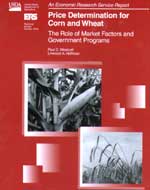Price Determination for Corn and Wheat: The Role of Market Factors and Government Programs
- by Paul Westcott and Linwood Hoffman
- 8/2/1999
Overview
Annual models for U.S. farm prices for corn and wheat are developed based on market factors as well as government agricultural commodity programs. The pricing relationships utilize a stocks-to-use modeling framework to capture the effects of market supply and demand factors on price determination. This formulation is augmented by factors that represent the changing role of agricultural policies, particularly government price support and stockholding programs. For wheat, international market effects as well as wheat feed use and related cross-commodity pricing considerations also are included. Model properties and model performance measures are presented. Additionally, recent price-forecasting applications of the models are discussed. The relatively simple structure of the estimated price models and their small data requirements lend themselves to use in price-forecasting applications in conjunction with market analysis of supply and demand conditions. In particular, the models have been implemented into USDA's short-term market analysis and long-term baseline projections. In these applications, the models provide an analytical framework to forecast prices and a vehicle for making consistency checks among the Department's supply, demand, and price forecasts.
Download
-
Entire report
Download PDF -
Frontmatter (Abstract, Table of Contents, Summary)
Download PDF -
Introduction
Download PDF -
Price Determination Factors for Corn and Wheat
Download PDF -
Previous Price Modeling Research
Download PDF -
A Pricing Model
Download PDF -
Model Implementation
Download PDF -
Model Results and Properties
Download PDF -
Evaluation of the Price Models
Download PDF -
Price Forecasting Applications
Download PDF -
Conclusions
Download PDF -
References
Download PDF

